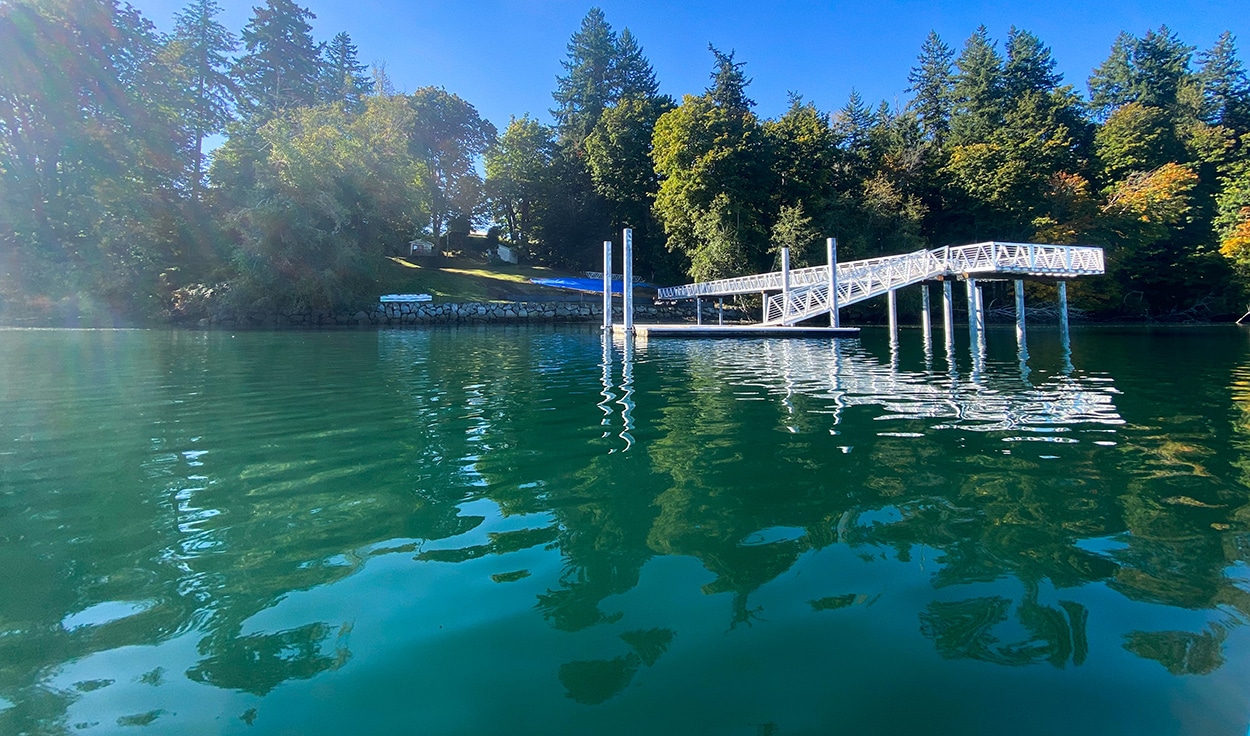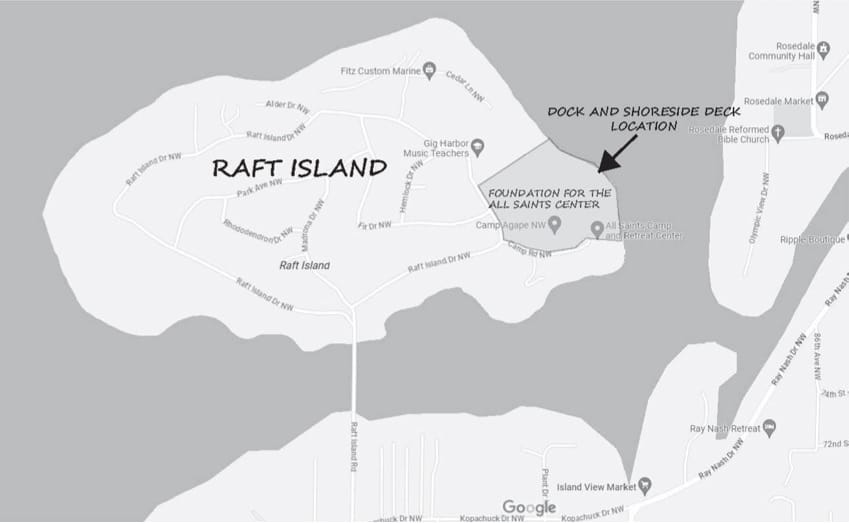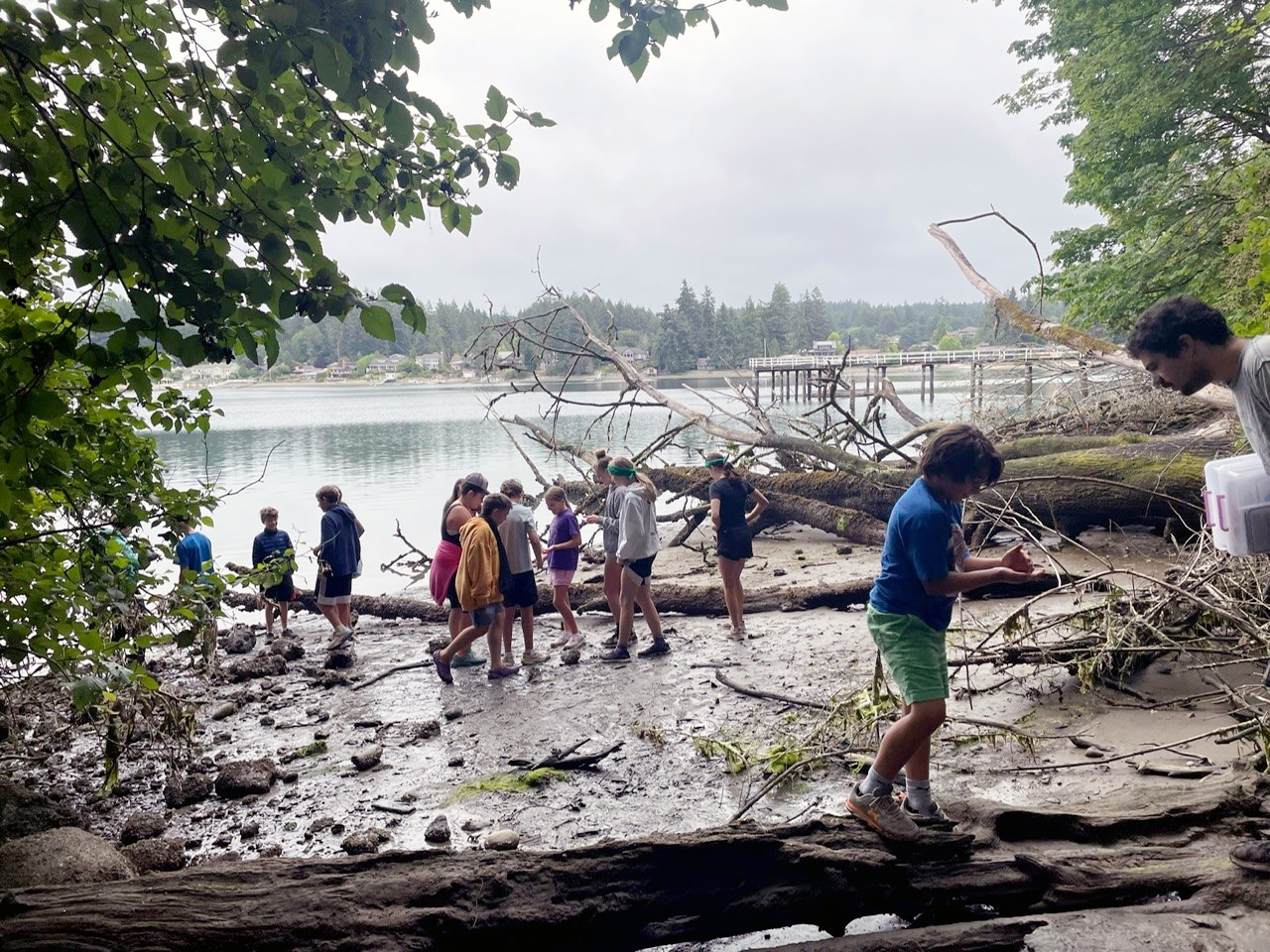Arts & Entertainment Community Environment Health & Wellness News
On Raft Island, the Peninsula’s last summer camp carries on, with updates
Residents on the east side of Lay Inlet enjoy looking across the bay at All Saints Camp and Retreat Center, a heavily forested stretch of Raft Island shoreline that provides a home to wildlife and brilliant fall colors. The view hasn’t changed in decades.
Neighbors might have worried earlier this month, when barges and heavy equipment pulled up at the 17-acre site. But when the vessels and gear shipped out a few days later, the only visible change was a spiffy new dock that replaced a dilapidated wooden one dating back more than 50 years.

The new dock at All Saints Camp and Retreat. Photo by Ted Kenney
All Saints Camp and Retreat, which is owned by the Greek Orthodox Church, is making some changes — but small ones. The Pierce County Planning & Public Works website describes the intended work at All Saints as “Non-profit camp master plan expansion and re-development.”
What’s planned
But Paul Plumis, an advisor to the camp’s board of directors, said the description sounds bigger than it is. The camp wants to replace its main lodge (which is not visible from the water) and a few cabins, and the county requires a new master plan first, he said.
The current lodge, which was there when the church acquired the camp in 1980, has “outlived some of its structural integrity and its functionality can be enhanced with a more updated model,” Plumis said.
“Currently the ‘lodge’ serves as a dining area and multi-use space simultaneously, which can prove challenging. Ideally, we can separate the dining space from the multi- use space in a future design. We also want to provide a facility for camper usage and youth gatherings far into the future,” he said.
Plans for the new lodge are expected to be completed within a year, he said.
The county’s planning department website placed a $400,000 project value on All Saints Camp and Retreat Center’s new dock and adjacent shoreside deck.

All Saints Camp is on the eastern side of Raft Island. Pierce County Planning and Public Works map
All Saints, the last of a breed
Gig Harborites may be surprised to learn a sleepaway camp still exists on the peninsula. There used to be several, including Camp Colman at the mouth of Horsehead Bay and Camp Ta-Ha-Do-Wa on Tanglewood Island (next to Fox Island).
They are long gone, but All Saints Camp and Retreat Center carries on the tradition.
Before 1980, the site at 205 Camp Road NW on Raft Island was Camp Blanchet, owned and operated for 30 years by the Roman Catholic Archdiocese of Washington’s Catholic Youth Organization (CYO). During this time, the camp maintained a higher profile on Lay Inlet than its Greek Orthodox successor would. Hundreds of young people from around Puget Sound descended on it every summer, arriving and departing by boat in the years before Raft Island’s bridge opened in 1957.
In one notorious incident in 1963, Camp Blanchet’s vessel, a 33-foot converted U.S. military landing craft called the Walrus, fell apart and sank in Henderson Bay while packed with campers en route from a sleepover on the Key Peninsula. Everyone onboard survived by holding onto a rope together, swimming to Cutts Island and then hollering until rescuers heard them. (See related story)

All Saints Camp & Retreat attendees beachcombing and exploring the camp’s muddy shore. Photo courtesy All Saints Camp and Retreat Center
A private island, for a time
Before Camp Blanchet, the property was a private estate. In July 1928, a Tacoma Daily Ledger article headlined “California Man Buys Island Here” announced that George O. Noble, a wealthy mining engineer, had acquired Raft Island’s entire 200 acres. The Californian planned a personal estate with “a private wharf, stables for riding horses, roads, trails and terrace landscaping,” the newspaper said.
The History of Raft Island, a booklet published by island resident Andy Buffington in 1998, explains that after Noble built his estate on site of the future Catholic and Greek Orthodox camp, he spent little time there and “by 1932 he had left the island for good.” (Noble did, however, bring electricity to Raft Island.)
In 1942, Jess Kuhns bought Raft Island for $30,000 and moved into Noble’s house, Buffington’s history says. The CYO bought the house and surrounding land from him and opened its facility — later named after the first Catholic bishop in the Pacific Northwest — in 1950.
By the late 1970s, the CYO decided to sell Camp Blanchet and invest the proceeds in its other camp properties. The island had by then become a “residential neighborhood,” the camp’s executive director told the Catholic Northwest Progress. The increasingly busy waters around the camp made it the CYO’s “least desirable unit.”
One church to another
When word leaked of Camp Blanchet’s possible sale, some neighbors contemplated buying it, as an investment but also to prevent its development. Many were relieved when the Greek Orthodox Church stepped up as a buyer, with a plan to keep it a camp.
Today, All Saints Camp and Retreat Center is a quiet neighbor, especially since the COVID pandemic cut attendance numbers. It is used for four or five weeklong camp sessions during the summer, Plumis said. Its capacity — with one cabin currently out of service — is 132 campers, but a typical session brings only about 50 kids and staff, he said.
The menu for campers “incorporates some Greek food — and it is enjoyed — along with traditional ‘camp’ style food,” Plumis said. Other aspects that differ from typical Boy Scout or YMCA camps are cabins named after Greek Orthodox saints, icon-making workshops, prayer service in the chapel and group discussions on the Orthodox faith. This is alongside “a regular camp program with arts and crafts, swimming, athletics” and more, Plumis said.
The camp is technically owned by the two Greek Orthodox churches in Seattle, but it is available to students in the area from all Greek and other Orthodox Christian churches, including Russian, Serbian, Antiochan (Syrian) and more, Plumis said. Some of these groups, like the Romanian Orthodox, can fill an entire camp session with their kids, while others send theirs to join the largely Greek Orthodox sessions.
“Unfortunately, it’s not used nearly as much as we would like to,” Plumis said of the camp. Its 501(c)(3) non-profit status limits its rentals to groups outside the Orthodox faith to 50 days per year, he said.
The challenge in filling the camp with Orthodox kids all summer is that there are simply not that many to draw from. “The pool of Orthodox kids in the churches, simply is not there,” Plumis said.
“Boy Scouts have used our camp in days when dollars were more plentiful for outdoor education, especially from Tacoma-area schools,” he said. “We just to need to encourage even more usage for such a great facility.”
Other groups using All Saints
One longstanding user besides the Orthodox youth camps is Camp Agape Northwest, an annual sleepaway camp for children with cancer from all faiths, and their families. It has operated at All Saints Camp and Retreat Center since 1997.
Camp Agape is one week per summer, during which neighbors of the camp can hear and feel its energy. Usually between 15 and 20 families participate, including parents, siblings and sometimes even grandparents. It is entirely volunteer-run, and can bring together as many as 100 staff members, including a one-one-one buddy for every child with cancer and their siblings.
“With the waterfront, accessible cabins, trails in the woods, sports courts, large green space, the chapel, and the kitchen, we have everything we need to give families experiencing cancer an amazing week,” said Christina Bradic, interim director of Camp Agape.
Another user of All Saints Camp and Retreat Center is Natural Spirit International (NSI), a martial arts school in Tacoma. Grand Master Kelly S. Worden has held NSI’s Water and Steel Three Day Martial Arts Training Camp at the All Saints facility every summer for the past 25 years, teaching the Worden Defense System, a “reality-based, non-sport martial art,” to as many as 85 students per session, he said.
The Raft Island site is natural and far enough from other people that attendees feel they’re “out there in the middle of the bush,” Worden said. The camp attracts martial arts practitioners from around the world, he said. “They just love the setting, the fact that the deer are right there, the otters are down at the dock.”
